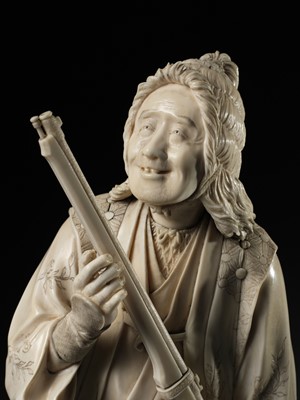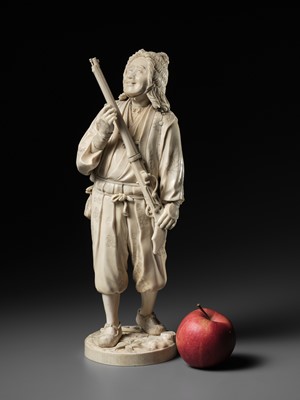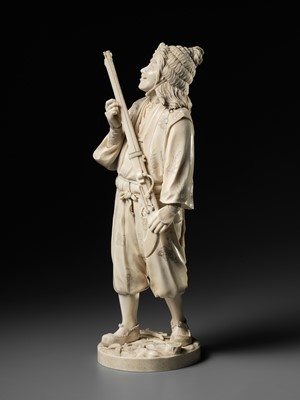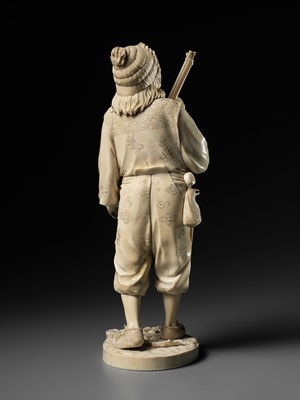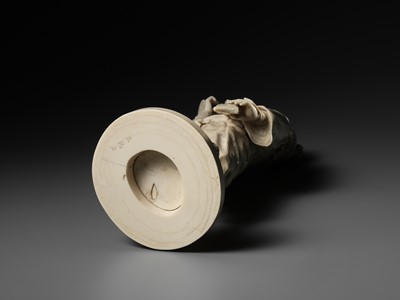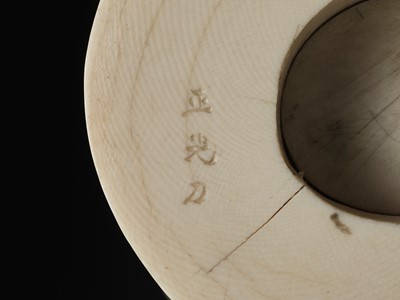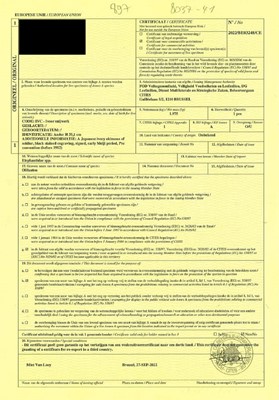16th Jun, 2023 11:00
Fine Japanese Art
268
Ɏ MASAMITSU: A RARE AND LARGE TOKYO SCHOOL IVORY OKIMONO OF A HUNTER WITH MATCHLOCK RIFLE (TANEGASHIMA)
Sold for €7,800
including Buyer's Premium
By Masamitsu, signed Masamitsu to
Japan, Tokyo, late 19th century, Meiji period (1868-1912)
Finely carved as a hunter standing on a naturalistically carved base with a twig, leaves, and a small tree stump. He is holding a matchlock rifle (tanegashima) in both hands, the gun finely rendered with both roughly textured and smoothly polished elements. His face with a pleased expression showing a bucktoothed smile with narrowed eyes looking upward, perhaps he has just shot a bird. He is wearing patterned robes over a bamboo undershirt, a pouch with netsuke is attached to his belt, and a straw hat tied below the chin over his wavy hair. The underside of the base incised with the signature MASAMITSU to [carved by Masamitsu].
HEIGHT 35 cm
Condition: Very good condition with minor wear and expected age cracks.
Provenance: Collection of Charles Rozenfeld, Antwerp, Belgium. Charles Simon Rozenfeld (1943-2020) was a Belgian diamond dealer and keen collector of Japanese art, particularly ivory.
Tanegashima, most often called in Japanese and sometimes in English hinawaju (‘matchlock gun’), was a type of matchlock-configured arquebus firearm introduced to Japan through the Portuguese Empire in 1543. Tanegashima were used by the samurai class and their ashigaru ‘foot soldiers’, and within a few years the introduction of the tanegashima in battle changed the way war was fought in Japan forever. After Tokugawa Ieyasu destroyed the Toyotomi clan in the siege of Osaka and established the Tokugawa shogunate, the relatively peaceful Edo period arrived, and the use of tanegashima declined. Isolation did not eliminate the production of guns in Japan—on the contrary, there is evidence of around 200 gunsmiths in Japan by the end of the Edo period. However, the social life of firearms had changed: as the historian David L. Howell has argued, for many in Japanese society, the gun had become less a weapon than a farm implement for scaring off animals. With no external enemies for over 200 years, tanegashima were mainly used by samurai for hunting and target practice, the majority were relegated to the arms store houses of the daimyo.
Auction comparison:
Compare a closely related ivory okimono of a hunter by Kyosei, dated late 19th century, Meiji period, 31 cm high, at Christie’s, 19 June 2002, London, lot 176 (sold for 8,365 GBP).
Trade Certificate: The trade certificate for the sale of this lot within the EU has been granted (permit number 2022/BE03248/CE).
By Masamitsu, signed Masamitsu to
Japan, Tokyo, late 19th century, Meiji period (1868-1912)
Finely carved as a hunter standing on a naturalistically carved base with a twig, leaves, and a small tree stump. He is holding a matchlock rifle (tanegashima) in both hands, the gun finely rendered with both roughly textured and smoothly polished elements. His face with a pleased expression showing a bucktoothed smile with narrowed eyes looking upward, perhaps he has just shot a bird. He is wearing patterned robes over a bamboo undershirt, a pouch with netsuke is attached to his belt, and a straw hat tied below the chin over his wavy hair. The underside of the base incised with the signature MASAMITSU to [carved by Masamitsu].
HEIGHT 35 cm
Condition: Very good condition with minor wear and expected age cracks.
Provenance: Collection of Charles Rozenfeld, Antwerp, Belgium. Charles Simon Rozenfeld (1943-2020) was a Belgian diamond dealer and keen collector of Japanese art, particularly ivory.
Tanegashima, most often called in Japanese and sometimes in English hinawaju (‘matchlock gun’), was a type of matchlock-configured arquebus firearm introduced to Japan through the Portuguese Empire in 1543. Tanegashima were used by the samurai class and their ashigaru ‘foot soldiers’, and within a few years the introduction of the tanegashima in battle changed the way war was fought in Japan forever. After Tokugawa Ieyasu destroyed the Toyotomi clan in the siege of Osaka and established the Tokugawa shogunate, the relatively peaceful Edo period arrived, and the use of tanegashima declined. Isolation did not eliminate the production of guns in Japan—on the contrary, there is evidence of around 200 gunsmiths in Japan by the end of the Edo period. However, the social life of firearms had changed: as the historian David L. Howell has argued, for many in Japanese society, the gun had become less a weapon than a farm implement for scaring off animals. With no external enemies for over 200 years, tanegashima were mainly used by samurai for hunting and target practice, the majority were relegated to the arms store houses of the daimyo.
Auction comparison:
Compare a closely related ivory okimono of a hunter by Kyosei, dated late 19th century, Meiji period, 31 cm high, at Christie’s, 19 June 2002, London, lot 176 (sold for 8,365 GBP).
Trade Certificate: The trade certificate for the sale of this lot within the EU has been granted (permit number 2022/BE03248/CE).
Zacke Live Online Bidding
Our online bidding platform makes it easier than ever to bid in our auctions! When you bid through our website, you can take advantage of our premium buyer's terms without incurring any additional online bidding surcharges.
To bid live online, you'll need to create an online account. Once your account is created and your identity is verified, you can register to bid in an auction up to 12 hours before the auction begins.
Intended Spend and Bid Limits
When you register to bid in an online auction, you will need to share your intended maximum spending budget for the auction. We will then review your intended spend and set a bid limit for you. Once you have pre-registered for a live online auction, you can see your intended spend and bid limit by going to 'Account Settings' and clicking on 'Live Bidding Registrations'.
Your bid limit will be the maximum amount you can bid during the auction. Your bid limit is for the hammer price and is not affected by the buyer’s premium and VAT. For example, if you have a bid limit of €1,000 and place two winning bids for €300 and €200, then you will only be able to bid €500 for the rest of the auction. If you try to place a bid that is higher than €500, you will not be able to do so.
Online Absentee and Telephone Bids
You can now leave absentee and telephone bids on our website!
Absentee Bidding
Once you've created an account and your identity is verified, you can leave your absentee bid directly on the lot page. We will contact you when your bids have been confirmed.
Telephone Bidding
Once you've created an account and your identity is verified, you can leave telephone bids online. We will contact you when your bids have been confirmed.
Classic Absentee and Telephone Bidding Form
You can still submit absentee and telephone bids by email or fax if you prefer. Simply fill out the Absentee Bidding/Telephone bidding form and return it to us by email at office@zacke.at or by fax at +43 (1) 532 04 52 20. You can download the PDF from our Upcoming Auctions page.
How-To Guides
How to Create Your Personal Zacke Account
How to Register to Bid on Zacke Live
How to Leave Absentee Bids Online
How to Leave Telephone Bids Online
中文版本的操作指南
创建新账号
注册Zacke Live在线直播竞拍(免平台费)
缺席投标和电话投标
Third-Party Bidding
We partner with best-in-class third-party partners to make it easy for you to bid online in the channel of your choice. Please note that if you bid with one of our third-party online partners, then there will be a live bidding surcharge on top of your final purchase price. You can find all of our fees here. Here's a full list of our third-party partners:
- 51 Bid Live
- EpaiLive
- ArtFoxLive
- Invaluable
- LiveAuctioneers
- the-saleroom
- lot-tissimo
- Drouot
Please note that we place different auctions on different platforms. For example, in general, we only place Chinese art auctions on 51 Bid Live.
Bidding in Person
You must register to bid in person and will be assigned a paddle at the auction. Please contact us at office@zacke.at or +43 (1) 532 04 52 for the latest local health and safety guidelines.
